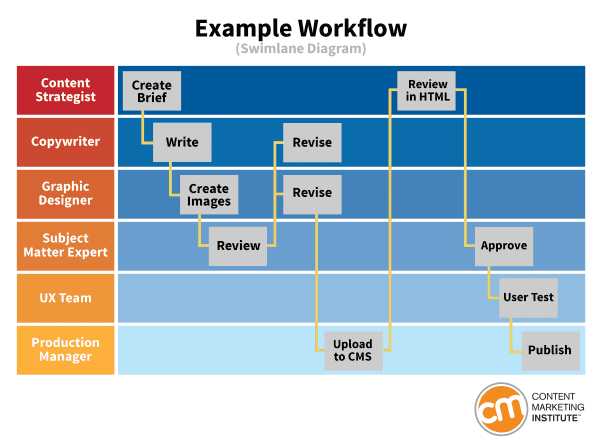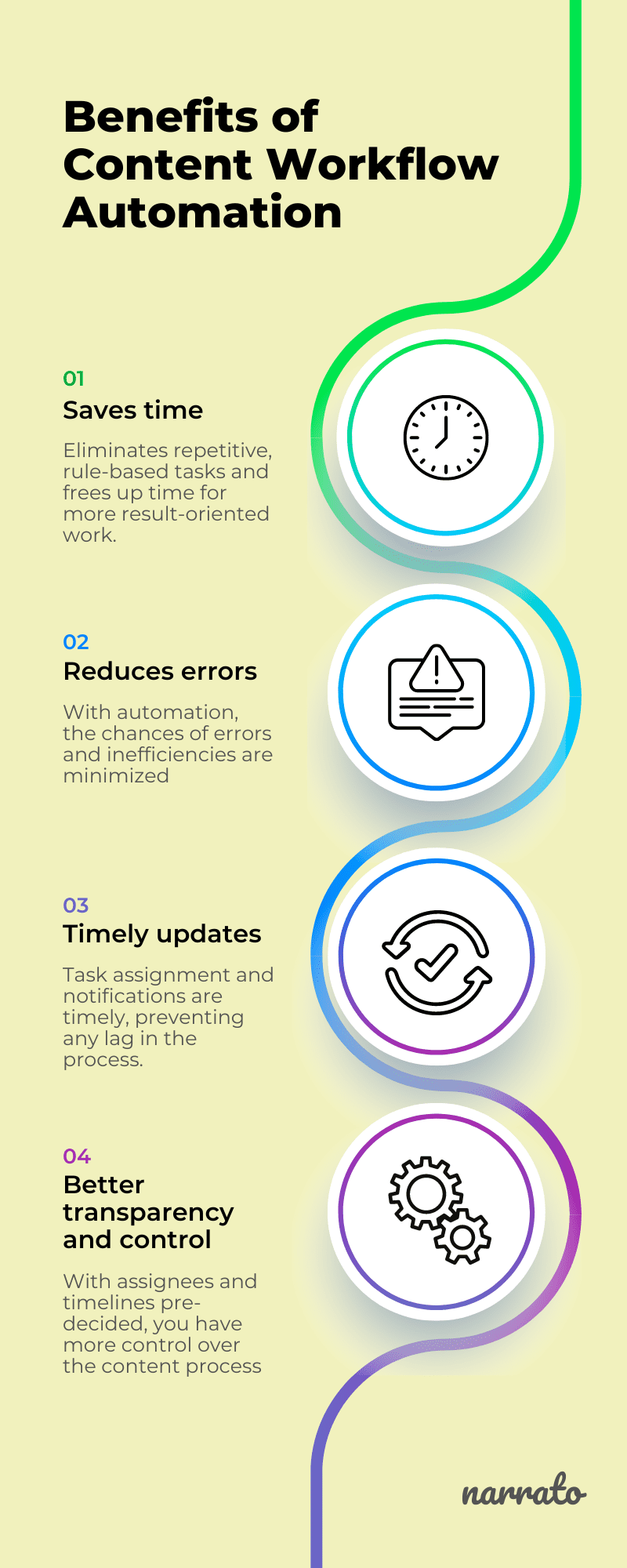Any business that invests in content marketing with certain goals and outcomes in mind, needs a content creation workflow to streamline their efforts. When every piece of content you create undergoes the same steps from planning to publishing, it ensures consistency in quality. But that’s not the only reason why most content marketing teams have a documented content workflow.
A strong content creation workflow can provide a solid structure to the way your team works. The real challenge, however, is not building a content creation process but implementing it and sticking to it in the long run.
We’ll learn all about successfully implementing a content workflow in this article. But before that, let’s find out how having a content creation workflow helps apart from organizing your efforts and bringing consistency.
TL;DR Here’s a quick summary video of this article.
- Why do I need a content creation workflow?
- Task-based workflow vs Status-based workflow: Which is best for your team?
- How to implement a content creation workflow successfully
- How to ensure your content marketing workflow sustains in the long run
- What are the best tools to use for content marketing and managing workflows?
- How to improve your content creation workflow

Why do I need a content creation workflow?
There are numerous benefits that a content team or an individual content creator can derive from efficient content workflow management. Here are a few ways a content process helps –
- Maintaining a standard of quality when creating content
- Maintaining a timely content publishing schedule
- Eliminating bottlenecks in the process before they can affect the production schedule
- Having clearly defined roles and responsibilities that help bring accountability
- Boosting productivity by eliminating unnecessary back and forth
- Ensuring optimum utilization of available resources and time
- Keeping track of projects and their progress
- Bringing more visibility and transparency to the content creation efforts
Task-based workflow vs Status-based workflow: Which is best for your team?
Not all teams can succeed using the same content marketing workflows. You need to implement a content process that is aligned with the way your team works and set realistic goals based on your team’s strength and capacity for long-term results.
Content workflows, in general, can be divided into two broad categories and your team may be comfortable with one of these based on their experience in the field.
Task-based content workflow
Task-based workflows are when you define the different stages of the content process based on the task that needs to carried out at that stage. The stages are defined quite elaborately and any team member working on the content project can easily understand what they’re required to do, what has already been done, and what the next step would be.
For example, a task-based workflow for your blog posts could look like this:
Carry out keyword research > Generate topic > Create a brief > Write content > Review and edit > Approve and publish
Here’s an example of a task-based workflow built on Narrato.

Status-based content workflow
In a status-based workflow, the stages are not as self-explanatory as in task-based. Here the workflow stages are defined in terms of the current status the content is in. So if your team members aren’t already familiar with your content process, they might have difficulty understanding what needs to be done.
The same blog content workflow would look somewhat like this if it is status-based:
Research > Ideation > Drafting > In-Review > Approved > Published
Here’s an example of a status-based workflow we created on Narrato.

Both of these types have their uses. Task-based workflows are better for newer teams that need more guidance on what to do at each stage. Status-based workflows are for more experienced teams who are already familiar with the process. Also, status-based workflows being more implicit can be applied to different content types, while task-based ones are usually specific to a content type.
How to implement a content creation workflow successfully
Once you’ve decided which content workflow best suits your content production requirements, the real uphill battle starts – implementing the process. Many a time, teams are successful in defining their content process but aren’t able to execute it correctly. This means all the effort you put into building the content workflow is wasted.
To ensure that your content team diligently and willingly follows your content marketing workflow, here are some best practices you need to adopt.
1. Delegate responsibilities
The first step in ensuring that everyone in the team adheres to the process you’ve set is making sure that work is equally and fairly distributed. If a few team members are overworked, it is likely that they might feel swamped and skip crucial steps in your content workflow to complete all their tasks.
When the workflow is being created, it is important to define the roles of each team member at different stages. When the workflow is being implemented, Project Managers and Administrators must ensure that individual responsibilities are being fulfilled by everyone. Team members must be held accountable for their own work to ensure a balance in the workplace.
Here’s an example of a content management workflow created by Content Marketing Institute, that shows how responsibilities can be delegated to different teams/individuals in content production.
2. Set realistic timelines
The next important practice is to set deadlines that are achievable. Content marketing leaders could tend to push their teams too hard to complete projects faster. This could be because you want to put the content out there before your competitors do or because you have an extensive pipeline of content that needs to go out. Whatever the reason, it is essential to remember that the more hastily you create content, the more the content quality would be affected.
If you set unrealistic timelines for the stages in your workflow, your team would be bound to cut corners and eventually, the workflow will yield no positive outcomes. Successful implementation of a content workflow happens when the timelines are logically planned, keeping everyone’s limitations in mind.
3. Track progress
Tracking progress at regular intervals can prove to be very useful. Waiting for the last date to receive the completed content piece is not an ideal approach as it limits your visibility. Monitoring progress at each stage will bring to light any bottlenecks or issues that are slowing down the process.
If every team member is meeting their deadlines at every stage, the final deadline will surely be met. Tracking your content marketing projects also ensures that none of the quality control steps are skipped and any loopholes in the process can be taken care of before it’s too late.
4. Send reminders
Sending reminders to your team members from time to time is also a good way to ensure that they follow the process. If you come across any inconsistencies when tracking progress, it is best to point them out to the person in charge, so they can act on them right away.
Even if there are no issues, checking in with your team members, getting updates, and sending reminders can be a good way to keep things on track.
5. Assign Project Managers to oversee each project
Irrespective of whether you’re implementing the same workflow across all projects or have multiple workflows to manage, it is always good to have someone overseeing individual projects.
Assign Project Managers with the task of monitoring different projects and ensuring that workflows are being followed. Project Managers must be aware of everything under a project, including the people involved, the deliverables, and the timelines. They must know if a project has any unique requirements for custom content creation. And of course, they must have a clear understanding of the workflow(s) being implemented. They must be able to provide team members with all the information they need to perform their tasks efficiently.
6. Automate to minimize effort
Implementing a content marketing workflow is already challenging but managing it manually is even more daunting. Using the right technology tools to manage your content creation process can make the job a lot easier. Content workflow management platforms, like Narrato, can help you build your content workflows as well as automate them to save you time and effort on implementation.
Many of the rule-based actions in the process, such as task assignment, notifying team members, etc. can be automated to make the process even smoother. We’ll discuss more about choosing the right workflow software in a while.
How to ensure your content marketing workflow sustains in the long run
By successfully implementing the content workflow, you’ve overcome the first hurdle. But a bigger hurdle awaits beyond this point and that is sticking to the workflow for years to come. Your content process could be effective and bring in great results but if your team isn’t able to stick to it every day, it will not hold together for long.
Here are a few ways to ensure that the content marketing workflow you’re implementing is sustainable.
1. Keep goals and expectations achievable
Having a well-defined content creation workflow allows you to scale content production by organizing your efforts, but it does not magically increase your content marketing team’s capacity. It might free up some of their time by minimizing rework and revisions, but their physical and mental capacity to work must still be accounted for.
Setting impracticable goals or overburdening them with work will affect their performance and the process will fail at some point.
So, say your writers were creating a piece of content in 10 hours before implementing the process, you can expect them to cut it down to 8 hours. But expecting them to write 2 pieces within this time is unrealistic. Or if the editor was editing 5 pieces a day and you now want them to edit 10, they will probably just end up skimming through the content instead of scrutinizing carefully. Setting such unachievable goals for them, will force them to deviate from the process just to meet targets.
Keeping your goals practical and achievable is the key to a sustainable process and a productive team.
2. Monitor performance and provide feedback
For a content marketing workflow to last, everyone on your team must thoroughly understand the process and the importance of every step involved. It is possible that team members may make mistakes or fail to realize the consequences of skipping crucial steps. This is where monitoring and feedback can help.
Project Managers or anyone who is in charge must continuously monitor everyone’s performance and offer timely feedback. Anyone who is doing good must be recognized and encouraged to keep up the good work. This will motivate them to adhere to the process in the future too.
For someone who isn’t performing equally or is struggling with the process, team leaders must take the time to offer help and guidance.

3. Identify gaps in the process
Sometimes the fault may not lie with the people but in the process itself. Gaps in your content production workflow may amplify and cause the process to fall apart in the future. That is why it is important to assess your content marketing strategy and content performance on a regular basis. If you do not see an improvement or worse, if there is a decline in performance, it could mean that the workflow is not yet perfect.
Identify the gaps in your process and try to find out how these gaps can be filled to make the workflow failproof.
4. Modify and optimize the content workflow
Your content workflow may stop yielding results not always because the process is inefficient or your team isn’t following it diligently. Sometimes the external environment changes too. Marketing trends change, audience preferences change. In such scenarios, the same content workflow may not bring you the desired results as it did before.
For instance, with the emergence of social media platforms like Instagram and YouTube as marketing channels, the inclination of the audience towards video content has increased. A brand that was only creating written content so far, cannot compete with others who are leveraging videos to grab audience attention. And video content demands a completely different content development process.
Revisiting your content creation workflow from time to time and making changes where necessary will help you keep it relevant and up-to-date. Like most other aspects of business, content marketing workflows also need continuous improvement.
5. Manage resources better
Another important aspect of making your process sustainable is how well you allocate your resources. A strong workflow without efficient resource management could still fail. If you are working with a small team, for instance, you cannot scale your content production beyond a point no matter how efficient the workflow is. So it’s important to understand what your current capacity is and where you need to build capacity for the best outcomes.
For instance, if you want to increase the rate of content production, you could try distributing the work between your in-house writers and freelancers. This will not only balance the workload for your team but will also be more economical than hiring more in-house writers. If you’re hiring freelancers from a content marketplace such as Narrato Marketplace, you can have content created with the same custom workflow that you follow in-house. Your Account Managers at Narrato marketplace can see to it that every piece of content created by a freelancer goes through the same quality control steps.
By managing your resources better, you can make your content workflow stick without exhausting your capacity.
What are the best tools to use for content marketing and managing workflows?
Apart from having a documented content marketing process, the right tools in your arsenal can also help you implement the workflow a lot more smoothly. There are a host of tools that a content marketing team needs to execute the process. Here are a few you should consider investing in.
Content workflow platforms
A content workflow platform like Narrato is a must-have for simplifying your content process. Workflow management tools usually allow you to build and automate your workflows with ease, making it easier to implement. On Narrato, you can build custom workflows with stages aligned to how your team works. You can also automate your workflow by triggering certain actions such as task assignment, notifying assignees, or moving due dates, every time the task status is changed. This eliminates a lot of the rule-based activities from the process, saves time, and ensures consistency.
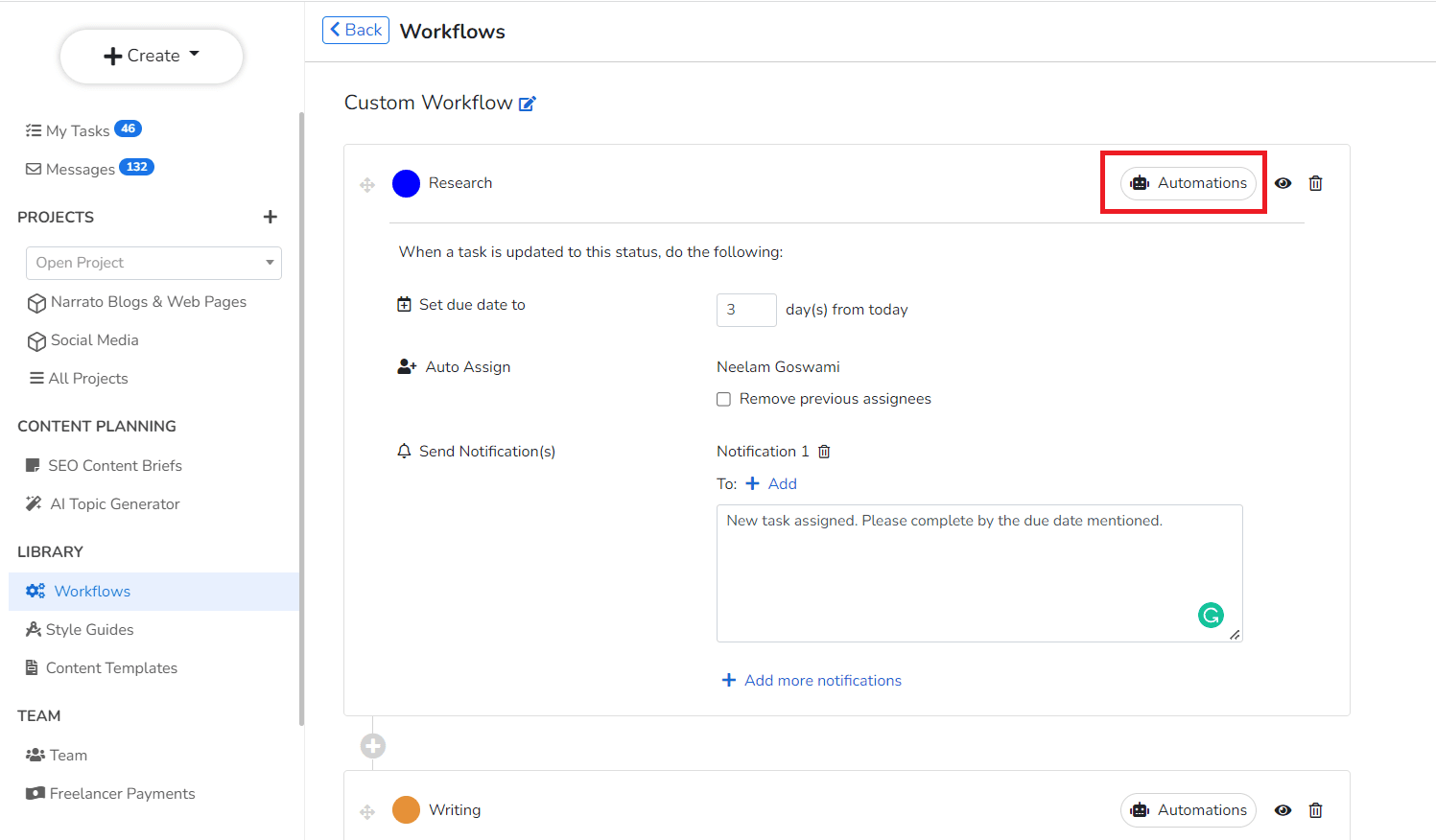
You can apply custom workflows to your projects so that every piece of content under the project goes through the same stages before being published.
As your entire team can create and collaborate on content on Narrato itself, the workflow management features ensure that everyone sticks to the process. Narrato also helps you execute your content creation workflows effectively with tools like the AI writing and SEO assistant.
Content calendars and content scheduling software
Certain steps in your content workflow can be a lot easier to execute if you have the right content planning tools. For instance, a content calendar tool can help keep everyone updated on your publishing schedules and deadlines to ensure that the workflow does not slow down. It also gives you a complete view of your projects and allows you to visually track their progress to know which workflow stage they are in, as in the case of Narrato’s content calendar.
Other than Narrato, a good editorial calendar tool would be Miro. Miro offers an editorial calendar template where you can easily plan your publishing schedules and streamline your workflow. It is also a team collaboration platform, so you can share the content calendar with your team to keep them in the loop.
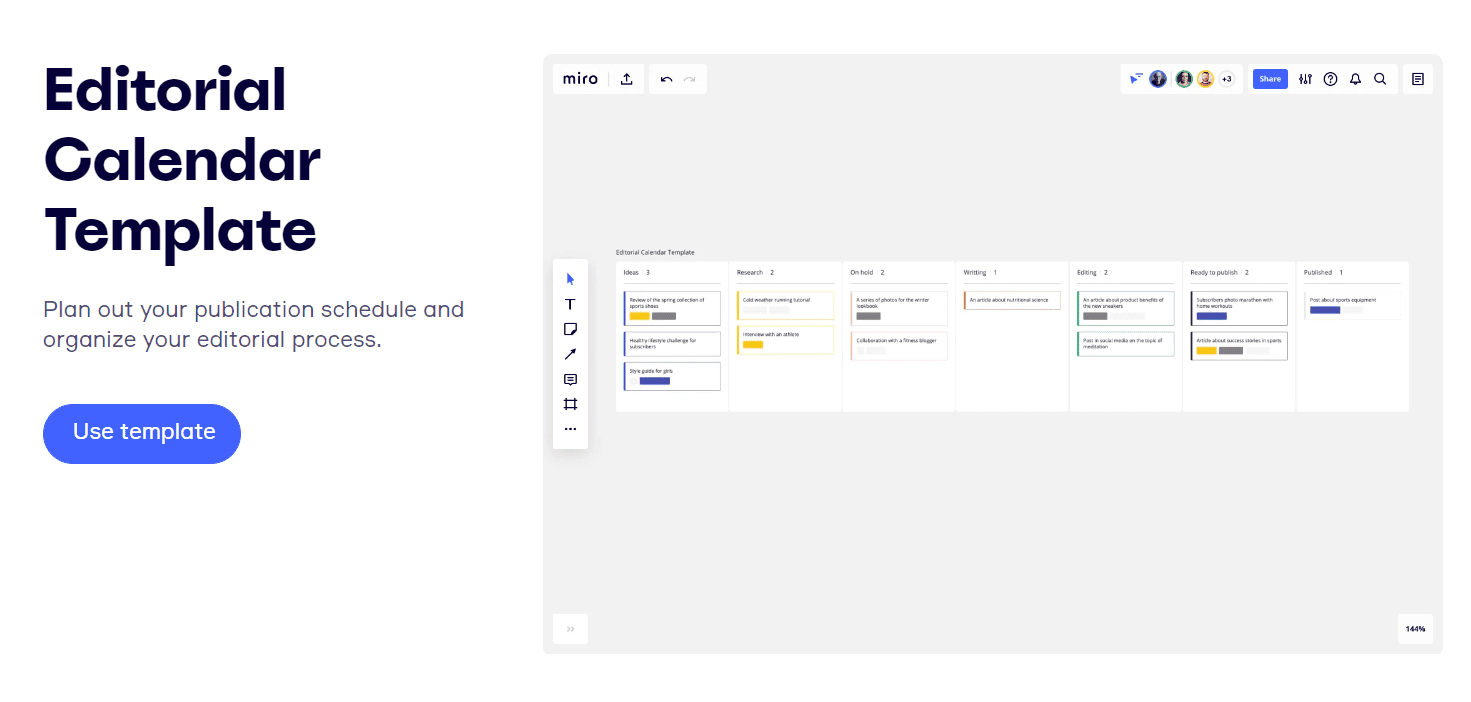
Content scheduling tools can also make publishing easier to ensure that your workflow is uninterrupted from start to finish. Scheduling tools can be particularly helpful when you are publishing content in huge volumes or on a daily basis, such as social media posts. A social media scheduling tool allows you to stick to your calendar without much effort.
A good tool for this is Hopper. Hopper has a host of features to help you with social media content planning, organizing, and design. It also allows you to auto-post content on all social channels including Facebook, Instagram, Twitter, and LinkedIn. You can schedule an unlimited number of posts at a time, so all you have to do is bulk upload your content on Hopper and schedule them according to your preferred time.
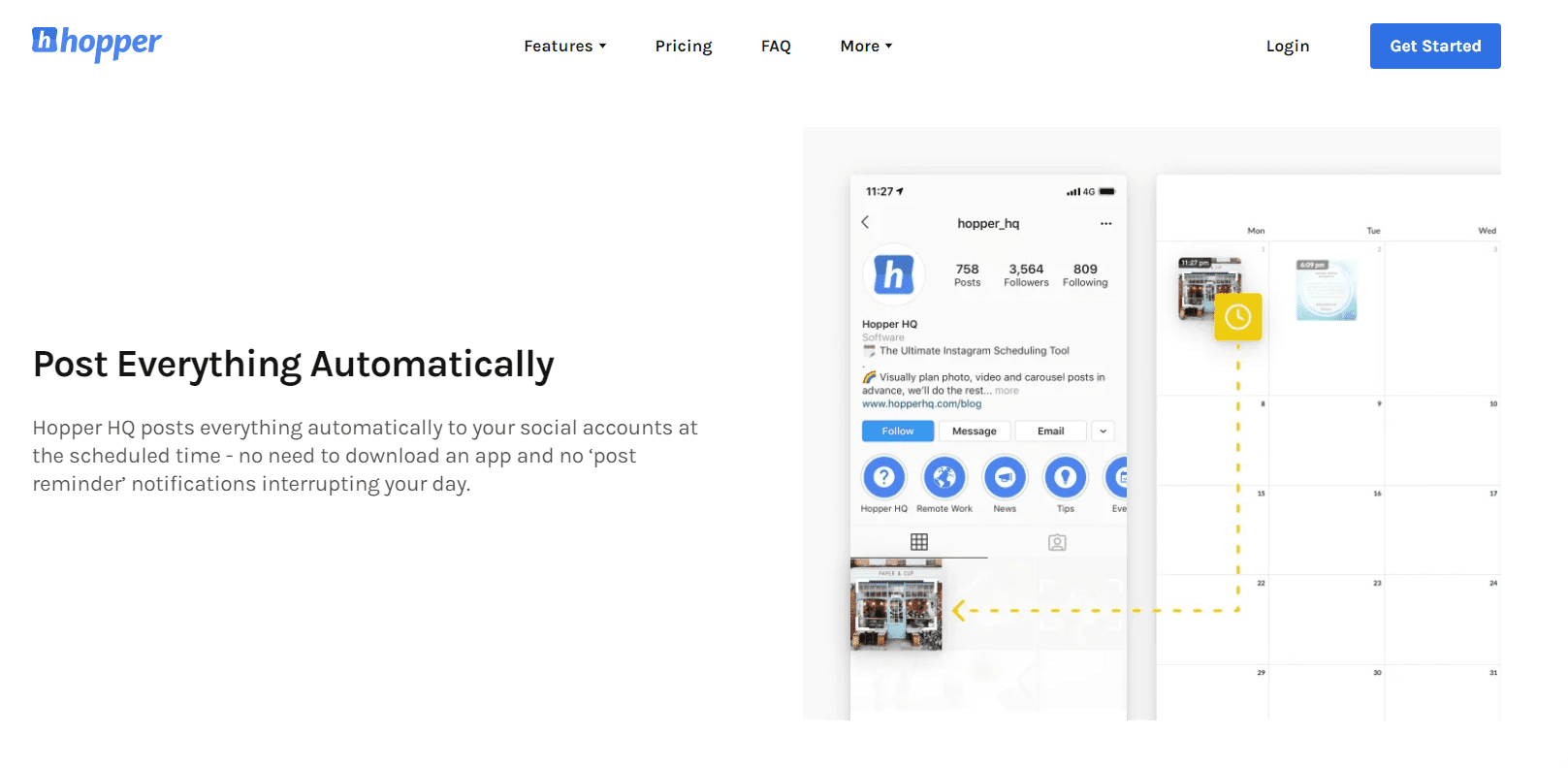
Content storage and management tools
Another very important aspect of a successful content workflow is how well all the resources, assets, and content created are being stored and managed. Making it easier for your team to find the resources they need in one place can significantly smooth out the process.
On Narrato, for example, you can save all your custom content templates, style guides, and SEO content briefs in a shared repository. Your team members can easily access these assets whenever they need to during the content production process. You can also store all your content items under neatly organized projects and folders on Narrato, making it easy to find them later.
Another useful tool for content storage and management that we can recommend is Box. It is a cloud content management and collaboration platform where you can securely store all your content and other assets. It integrates with a host of other platforms like Microsoft Word, Excel, Powerpoint, Adobe Reader, and others, to easily upload your files to Box.

Other features like collaboration through comments, file sharing, and e-signatures for approval can speed up your process too.
How to improve your content creation workflow
There are also ways to improve your content creation workflows for better outcomes. We’ve already mentioned above that workflows need continuous improvement. So how do you achieve this? Here are a few tips.
Have a method of prioritizing tasks in your workflow
No matter what you are creating, every process needs a certain amount of flexibility. Your content workflow too should be able to pivot when the need arises. You might often find yourself in situations where you need to prioritize certain tasks over others in your workflow.
For example, social media posts do not require content SEO research but a blog post will need extensive research. If you are using the same content workflow for both projects, you might have to prioritize research for blog content, while for social media you will have to prioritize content creation to stay on schedule.
Or say you’re working on different client projects that have different priorities. One client may be very particular about adhering to brand guidelines, in which case you have to prioritize content planning. Another client may not be too stringent about guidelines but just wants a rich article that offers value to their audience. In this case, you will have to prioritize research.
So not making your workflow too rigid and being able to move workflow stages up or down as per need can be a big help.
Make use of content briefs to guide content creators
A documented content workflow already adds some structure to your content production efforts. But to make your team more productive and your process a lot more streamlined, it is always a good idea to share a content brief with your content creators.
A content brief provides direction to their efforts by laying down all that is required. To share instructions with your content creators on Narrato, you can generate automatic SEO content briefs that give keyword suggestions, topics and questions to cover, competitor content to benchmark against, and more SEO parameters. You can add your own notes to authors and also attach style guides with the content task, to give writers all the information they need.
Having this guidance makes it easier for them to follow the process.
Make all content easily accessible
According to a survey, nearly 54% of U.S. professionals agree that they spend more time hunting for files than responding to work emails or messages. This is valuable time wasted on an activity that is necessary but has very little impact on results. This is where the content storage and management tools that we recommended above can help you improve your workflow.
To make your content workflow smoother, make sure that your team can access all the resources they need easily, in a single place, and from anywhere. For someone creating content on Narrato, for instance, all the content tasks are stored under dedicated projects and folders, all the templates and style guides are stored in the Library and all SEO content briefs are stored under Content Planning tools. This means they don’t have to leave the platform or run from pillar to post to find an asset.
This saves you a lot of time which can be used for more productive work.
Allow easy review and approval of content
Bottlenecks in a content marketing workflow result when the approval processes are too siloed. Content keeps piling up for review and approval, slowing down all the other projects in the pipeline. For a content workflow to be truly successful, you must make content review and approval as seamless as possible. Having a powerful content collaboration platform can help with this.
On Narrato, Editors or other stakeholders in a content project can leave on-task comments with @mentions to share inputs and feedback. They can also leave messages on the task. This makes the editing process a lot easier and minimizes unnecessary back and forth, so the content can go from the first draft to approval pretty quickly.
The smoother it is to get content approved, the more your team would be willing to stick to the process.
Wrapping up
While you may have put in a lot of effort in building your content creation workflow if the implementation is not right your workflow will fail in the long run. Making sure that the process is failproof and that everyone on your team is willing to follow it is the real challenge. With these tips and tools, implementing your content workflow should be a hassle-free experience. But remember that continuous monitoring and improvement are the keys to content marketing success, even when it comes to content workflow management. So always keep an eye out for opportunities to better your process.



